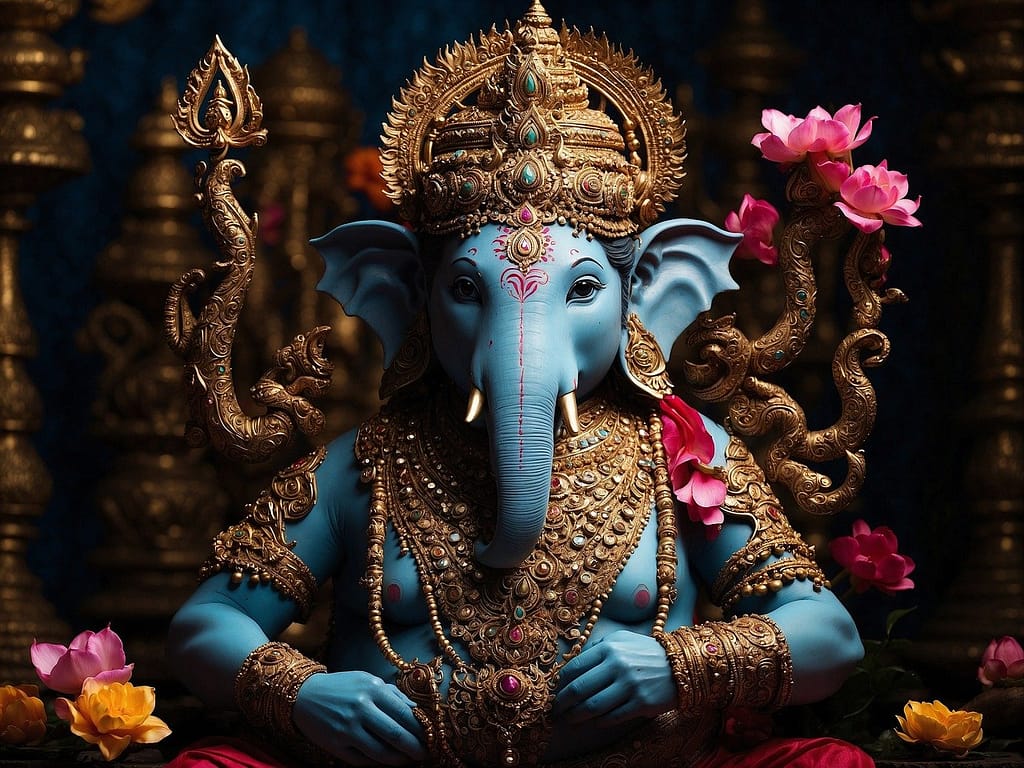Hinduism, one of the world’s oldest and most complex religions, has roots in the ancient Indus Valley Civilization, which dates back over 4,000 years.
With no single founder or precise date of origin, Hinduism evolved over millennia, absorbing and adapting various cultural and religious elements.
It remains a major world religion, with over 1.2 billion followers, primarily in India, Nepal, and the global Indian diaspora.
At the heart of Hinduism is a rich tapestry of beliefs and practices, many of which revolve around worshipping deities in physical form.
This practice, often labeled as idolatry by outsiders, is central to Hindu devotion, a stark contrast to monotheistic religions like Christianity, which prohibits the worship of images or idols.
Founding and Evolution of Hinduism
The early development of Hinduism is closely linked to the Vedic period (c. 1500–500 BCE), during which the sacred texts known as the Vedas were composed.
These ancient scriptures, written in Sanskrit, laid the foundation for Hindu rituals, philosophy, and social structures.
The Vedas primarily focus on worshipping natural forces, such as fire (Agni) and wind (Vayu), as manifestations of divine power and were central to performing elaborate rituals.
As time passed, Hinduism’s focus expanded from ritual sacrifices to more personal forms of devotion, and new texts like the Upanishads (c. 800–200 BCE) emerged.
These writings emphasized inner spirituality and introduced the concepts of Brahman (the ultimate reality) and Atman (the individual soul).
During this period, worshiping personal deities, such as Vishnu, Shiva, and Devi, gained prominence.
During its time, the Bhagavad Gita, a highly respected Hindu text, emphasized the importance of devotion to a personal god, or bhakti.
The Gita encourages worship of Krishna, an avatar of Vishnu, who teaches that surrendering to a personal god is a path to liberation (moksha).
Idolatry in Hinduism: A Defining Practice
Hinduism is often considered idolatrous because of its widespread use of images, statues, and symbols to represent the divine.
Hindu religious practice involves the fundamental worship of murtis. Murti puja is a devotion that emphasizes the divine presence that the idol represents rather than merely demonstrating respect for a material object.
Several scriptural references affirm the importance of deity worship in Hinduism. For example, the Bhagavad Gita (9:22) states:
“To those who are constantly devoted and who worship Me with love, I give the understanding by which they can come to Me.”
This verse emphasizes the importance of devotion and worship in connecting with the divine, often mediated through images or idols.
The Vishnu Purana (1.23.54) encourages devotees to honor and serve pictures of the holy, recognizing them as sacred conduits for divine blessings.
Murtis in Hindu temples are living manifestations of the divine. They are bathed, clothed, fed, and worshipped with offerings of flowers, incense, and prayers.
These rituals are acts of love and devotion, helping the worshiper establish a personal connection with the deity.
Idolatry vs. Christian Beliefs
Christianity, especially in its Protestant forms, has historically condemned the worship of images as idolatry, drawing on biblical commandments against the worship of graven images. In Exodus 20:4–5, the Bible declares:
“You shall not make yourself an idol or likeness of what is in heaven above, on the earth beneath, or in the water under the earth. You shall not worship them or serve them.”
This prohibition stems from believing in a single, transcendent God beyond physical representation.
Contrary to this, Hinduism considers its multiple deities as manifestations of Brahman, the ultimate reality, and uses physical representations of these deities as tangible objects of worship.
While Christianity emphasizes God’s abstract, non-representational nature, Hinduism embraces the idea that the divine can take form. This fundamental difference highlights the divergent paths the two religions have taken regarding the relationship between humanity and the sacred.
Practices Defining Hinduism as an Idolatrous Religion
- Murti Puja: Worship of idols or images representing deities.
- Pratima: The creation and consecration of statues representing the gods.
- Darshan is the term for seeing and experiencing the deity, commonly through the idol.
- Alankara: The decoration and adornment of idols with flowers, jewels, and garments.
- Prasada: Offering food to the deity and later consuming it as a blessed gift.
- Arati: The waving of lighted lamps before the deity’s image.
- Abhishekam: Ritual bathing of the deity’s image with milk, water, or other substances.
- Yatra: Pilgrimage to temples or places associated with idols of specific deities.
- Home: The offering of sacrifices to fire, representing the divine.
- Namaskar: The act of bowing before the deity’s image in reverence.
- Chanting Mantras: Reciting sacred formulas before the idol.
- Puja Thali: Offering a plate of items like rice, water, flowers, and lamps to the deity’s image.
- Sankalpa: Making vows or promises in front of the deity’s idol.
- Vrata: Adhering to fasts and rituals in honor of a god represented by an idol.
- Japa Mala: Using prayer beads to chant the deity’s name in front of its image.
- Temple Prasadam Distribution: Receiving and sharing offerings consecrated before an idol.
- Ganga Snan involves bathing in the holy Ganga river and immersing statues of gods.
- Temple Processions: Taking idols of deities in public parades during festivals.
- Prana Pratishtha: The ritual of invoking the divine presence of an idol.
- Vrat Katha: Reciting stories of deities in front of their images during religious ceremonies.
- Ratha Yatra: The chariot festival where images of deities are paraded through the streets.
- Bali: Offering animal or plant sacrifices before an idol.
- Gopuja: Worshipping the cow as a divine manifestation, often with its idol present.
- Linga Worship: The adoration of the Shiva Linga, a symbolic representation of Lord Shiva.
- Tulsi Puja: Worship of the holy basil plant as a manifestation of Vishnu or Lakshmi.
- Pavitraropana: Tying sacred threads around the deity’s idol.
- Akhanda Deepa: Keeping a continuous lamp lit before the deity’s image.
- Kumkum Tilak: Placing a holy mark on the forehead of the idol as a sign of respect.
- Devotional Songs: Singing hymns in front of the idol during worship.
- Ganesh Chaturthi honors Lord Ganesha’s birthday by immersing large idols in water.
Differences in Practices Between Hinduism and Christianity
One key difference between Hinduism and Christianity is the use of idols in worship. Christianity, especially in its Protestant traditions, adheres to the biblical commandment against creating and worshiping graven images.
The Bible teaches God is Spirit and true worshippers must worship “in spirit and truth” (John 4:24). This emphasizes an abstract, non-representational view of divinity.
Hinduism recognizes many deities, each with the ability to be portrayed.
Hindus believe the divine can take on both formless (nirguna) and form (saguna) aspects and that worshipping an image of the divine helps devotees focus their minds on higher spiritual truths.
This practice is firmly embedded in daily life, rituals, and temple worship, contrasting with Christian prohibitions against idolatry.
Another significant difference is the concept of salvation. Christianity teaches that salvation is through faith in Jesus Christ, seen as the only path to eternal life.
Hinduism, however, offers multiple paths to liberation (moksha), including devotion (bhakti), knowledge (jnana), and right action (karma), and does not require adherence to a single deity or form of worship.
Conclusion
Hinduism’s rich tradition of deity worship and the use of idols is a defining characteristic of the religion, setting it apart from monotheistic faiths like Christianity.
While Christians often view idolatry as a violation of divine law, for Hindus, the worship of images is a way to access and experience the divine presence.
Despite these differences, both religions offer profound spiritual paths, each shaped by its own unique history, scriptures, and cultural practices.
As Hinduism continues to thrive around the world, its practices of devotion through idolatry remain a central aspect of its identity.
Hinduism is an idolatrous and false religion that has broken the first commandment, which says in Exodus 20:3, “You shall have no other gods before me.
Without salvation in Jesus Christ, Hindus wander in spiritual darkness, for Acts 4:12 affirms that no one else can offer salvation, as there is no other name under heaven given upon humanity for our redemption.
All the Hindu gods and deities cannot help them spiritually, and they have no life.
The Bible states in Hebrews 7:24–27 that life exists solely in Jesus Christ, who remains forever. 24 Because Jesus lives forever, he has a permanent priesthood. 25 Therefore, he can ultimately save those who come to God through him because he always lives to intercede for them.
26 Such a high priest truly meets our need—one who is holy, blameless, pure, set apart from sinners, exalted above the heavens. 27, unlike the other high priests, does not need to offer sacrifices daily, first for his sins and then for the people’s sins. He sacrificed for their sins once and for all when he offered himself.
“Hindus need to embrace Christ to receive forgiveness for their sins and attain salvation.”
Failure to heed this warning would cause the eternal perishing of their souls, contrary to God’s plan.
The divine intent is for adherents of Hinduism to embrace the teachings of the gospel of Christ earnestly, gain a profound understanding of His mission, and aspire to accept Him as their Redeemer and Master, thereby ensuring their inclusion in the Book of Life.
The Bible says in John 3:18, “Whoever believes in him is not condemned, but whoever does not believe stands condemned already because they have not believed in the name of God’s one and only Son.”
Hindus need to leave behind their malevolent traditions and idol-worshipping religion and instead seek salvation in the Living Savior, Jesus Christ.



